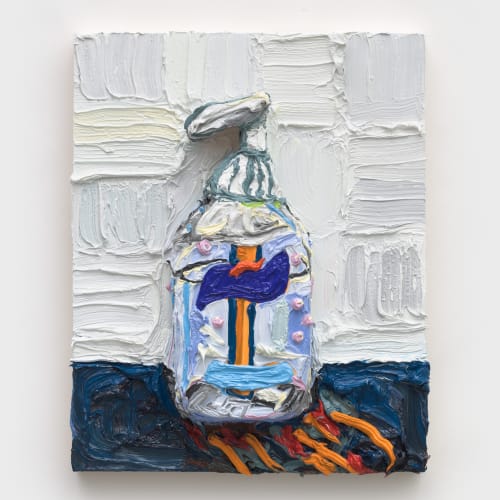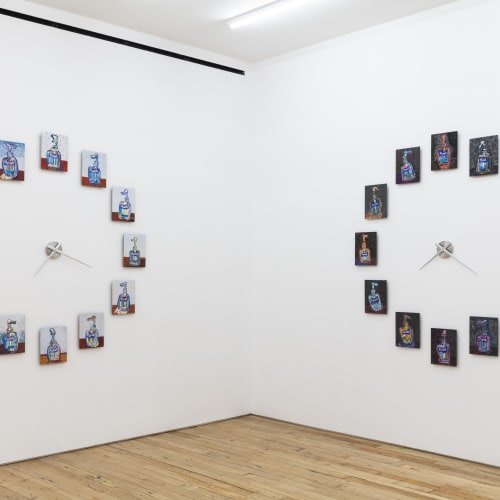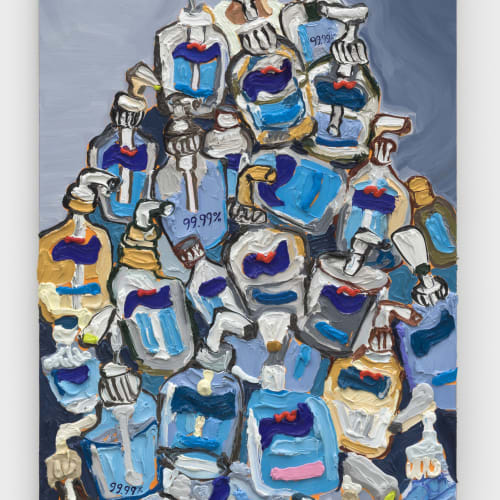The Many Lives of a Purell Bottle
In Purell Night & Day, Susan Chen focuses on the ubiquitous hand sanitizer, a reminder of the isolation we experienced during the lockdown.
John Yau, August 7, 2023
I first saw Susan Chen’s debut exhibition at the Meredith Rosen Gallery in August 2020, six months after the start of the COVID-19 pandemic and resulting lockdown. Among her portraits and depictions of friends and groups of people, her self-portrait, “COVID-19 Survival Kit” (2020) stood out. She used thick brushstrokes to depict herself in a gray T-shirt sitting on a brown throw rug in the middle of an undecorated room, surrounded by essential items: cans of beans, cough drops, cleansers, aspirin, and other necessities, such as a loose roll of toilet paper unraveled on the floor behind her. A fluffy white dog sits on her lap. A large television shows Dr. Anthony Fauci beside the daily statistics of reported COVID-19 cases, and related deaths. The thick paint, dog, and assorted necessities seemed to be the only wall Chen could construct between herself and the pandemic. The painting was smart, vulnerable, tough, and refreshingly earnest, as was her expression of bewilderment and anxiety in it.
Chen’s ability to use thick paint to convey her sense of humor is evident in her current exhibition, Susan Chen: Purell Night & Day at Rachel Uffner Gallery. Before March 2020, hand sanitizer and phrases like “social distancing” were not integral to most people’s daily lives. While that catastrophic change has largely passed, and vaccines have weakened the virus’s power, remnants of its presence remain. We have “contactless” exchanges and deliveries. Signs telling us to stand six feet apart remind us of our recent past.
All 11 works in the show focus on a small bottle of Purell, the ubiquitous hand cleanser. Perhaps because she has a single subject, Chen expands into new areas in her art. She created two clocks by arranging 12 soft pastels on board in a circle, with working clock hands in the center; these are the first works in pastel I have seen by her. In “Purell Clock: Night” (2023), she depicts the bottles against a gray background; in “Purell Clock: Day” (2023), the bottles are set against a pale blue background. Some bottles appear to be on the verge of collapse while others stand up straight and sturdy. Each has an animated presence. Although the subject is the same, each one is distinct in its color combination, suggesting that Chen is a skilled colorist who has just started exploring this possibility. One bottle is salmon colored; another has Barbie-pink highlights. Do the red and blue dots floating against the mottled dark gray background in one of the pastels represent the mutating virus?
At the top of the large oil painting “Purell Tower” (2023) is Chen’s head, with a cascade of Purell bottles forming her body. The used and crumpled plastic bottles compose tower, a gown, and a suit of armor. While the sanitizer may have helped us, we also generated a huge amount of waste. The painting is absurd, edgy, and funny. Chen doesn’t editorialize in the work — she loves using paint’s materiality to physically and visually bring to life ordinary things, as evidenced in her early work.
“Purell Bulk Mini” (2023) uses acrylic, foam, and epoxy to depict the bottle against an impasto ground. By building up the bottle with epoxy and foam, Chen produces a low relief. The ground is divided into rectangles, with thick, bluish-white paint laid down horizontally and vertically, like stucco. Orange stripes extending diagonally from the bottle’s bottom edge look as if they have been squeezed directly from the tube, like toothpaste. The lone form might remind some viewers of the isolation they experienced during the lockdown, the feeling that the outside world had become remote.
In an exhibition full of small surprises, the ones that most struck me were the four charcoal drawings of a Purell bottle. The graphic directness of these drawings — no smudges and erasures — stood out. Chen refutes the messiness of charcoal with her pristine images. I was reminded of Philip Guston’s drawings from the 1970s, the directness of his line. What Guston and Chen share is a cartoonist’s aspiration for a distinct and immediately legible image that carries a trace of the artist’s affection for things: shoes and plastic containers. Chen’s desire for lucidity and love for her materials, be they oil paint or soft pastel, imbue her work with its distinct charm.




